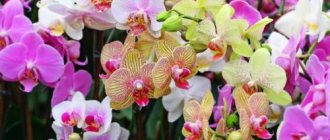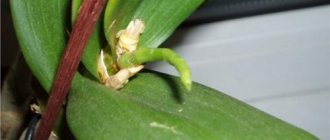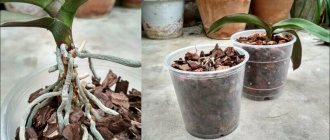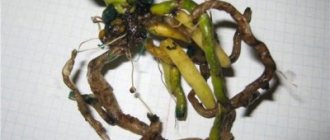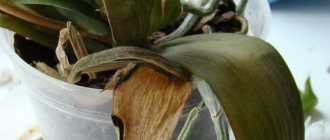The orchid does not grow or bloom, what should I do to make it bloom? When development stopped
If the orchid has stopped blooming, does not form flower arrows and does not produce leaves, you need to analyze the conditions in which the plant is kept. Sometimes it is enough to change watering, add lighting or bring the temperature back to normal and the problem of lack of flowering is quickly solved.
Substrate
In order for an orchid to bloom, it is important to grow it only on suitable soil. Regular soil is not suitable for this flower. It absorbs a lot of liquid and contains high concentrations of minerals. Also, a substrate based on sphagnum moss is not suitable for cultivating orchids. It has a high moisture capacity and can cause rotting of the root system.
Important!
If the soil is not selected correctly, a putrefactive process in the roots will necessarily develop. A diseased epiphyte does not bloom.
Sometimes the reason that flowering does not begin is the unbalanced mineral composition of the soil. With a high nitrogen content, the root system and greenery grow. Increased phosphorus content is important to encourage flowering. To feed an orchid, do not use conventional mineral complexes. This plant needs special, liquid forms, which are applied before the peduncle begins to grow. When the peduncle and buds form, you need to stop feeding the orchid.
How to distinguish the root from the peduncle of an orchid: care recommendations An orchid is a fascinating and unusual flower. Phalaenopsis grows in many homes and is quite popular. For…
Lighting
Most varieties of orchid plants bloom only with prolonged light. They need a lot of indirect light to bloom. Direct ultraviolet rays are unacceptable, as they cause burns on the leaf plates. Daylight hours for epiphytes last 12 hours. Therefore, in autumn and winter it is increased artificially by illuminating the flowers with phytolamps.
Temperature and humidity
The tropical forest in the homeland of epiphytes is humid and warm. Therefore, when cultivating an orchid in an apartment, you need to create the same conditions for it to bloom. In summer it is kept at temperatures from +15 to +30 degrees. In winter, the suitable temperature range is from +20 to +23 degrees. To make a phalaenopsis orchid bloom, the fluctuation between day and night air temperatures must be 5 degrees.
Proper watering
Beginning gardeners often get carried away and water the orchid too much. Therefore, the flower does not experience a physiological need to bloom. Under natural conditions, abundant irrigation of the flower occurs during the rainy season, when the orchid begins to grow roots and leaves. Excess moisture often provokes putrefactive processes, which can also cause a lack of buds. To eliminate rotting, the affected parts of the roots are cut off, these places are treated with activated carbon and the orchid is transplanted into a fresh substrate.
Emergency measures if the orchid:
Doesn't grow new leaves
Give the plant a short period of drought , then treat the leaves by spraying with succinic acid or another growth stimulant.
Does not form flower stalks
Succinic acid will help , the difference between night and day temperatures with a difference of 5 degrees.
Succinic acid will help to grow the peduncle.
Doesn't grow a stem
It is necessary to feed the plant with fertilizers so that the leaves grow; the more leaf blades, the larger the stem.
Slows down the growth of roots, including aerial ones
Treat with succinic acid (spill the roots) or treat with the newest preparation HB-101 , it can be purchased at specialized flower shops.
The orchid grows, but does not bloom, what to do to make it bloom. Analysis of orchid keeping conditions
When buying a flower, you need to ask a specialist for an explanation of what variety it is and the characteristics of its cultivation. Phalaenopsis orchid, the most unpretentious variety that tolerates light shading. But there are orchids for which a south window is suitable, and even summer heat is tolerated well by them. An orchid does not bloom if the conditions of its maintenance are violated.
You should always place a saucer of boiled water next to the orchid. Place a clove of garlic in the substrate.
If the flower was purchased in a store, and it was already blooming, and the arrow turned yellow, then the rest period can last up to a year. If the plant is grown from children, then it will take more than two years to wait for the first flowering. By this time, the root system will gain strength and the orchid will produce 5-6 leaves. Early flowering will weaken the beauty.
Why doesn’t an orchid bloom at home after transplantation? When should we expect the first arrow? The transplanted plant initially builds up its root mass within six months. Afterwards, aerial roots develop and leaves grow. Flower buds are formed in the axils. The initial period of plant development in favorable conditions contributes to the laying of a larger number of flower stalks.
Let us remind you how to properly maintain an orchid:
- The roots are well developed, green, some of them are located on the walls of the transparent pot, some are at the top, absorbing moisture from the air.
- The substrate does not contain fresh bark, sawdust or manure.
- It is better to keep the lighting diffused.
- The difference in day and night temperatures when planting flower stalks should be at least 5 degrees.
- Fertilizing with liquid fertilizers depleted in nitrogen once every 10 days before the arrow shoots.
The conditions for laying flower buds are listed, but biological requirements for the maintenance of orchids must be observed.
What to do if the orchid does not bloom or develop well? It will be necessary to provoke the release of the arrow. The aerial root and the arrow look the same at first. But the tip of the arrow is rounded, and at the root it is sharp, as in the photo.
Orchids in nature
In tropical conditions, nature has created ideal conditions for plant growth . After all, there is no constant care there, they grow there without human supervision and feel great. In the tropics, these flowers grow almost everywhere and each rosette has 1-2 peduncles with beautiful flowers. The root mass is quite powerful and clings well to tree trunks.
This is how orchids grow in the wild.
Favorable environmental conditions
The tropics provided excellent conditions for the growth of epiphytes:
- sufficient daylight hours, lasting at least 14 hours ;
- temperature regime in the range of 23-28 degrees Celsius ;
- At the same time, the humidity is almost at the level of 100% and amounts to 90%.
You should try to organize all these parameters at home in order to get a beautiful orchid bush.
Regions and countries of distribution
Let's first figure out in which country the orchid grows. These flowers are distributed all over the world , they are not found only in Antarctica. Scientists have divided all orchid plants into groups growing according to different climatic zones:
- Central and South America, the coast of Africa and all other coasts of the tropics, located on an identical parallel;
- Andes, mountains located in Brazil, Malaysia, New Guinea;
- The forest-steppe and plateau zones are inhabited by a small group of orchids;
- The fourth climate zone has a small species of terrestrial orchids.
IMPORTANT! In the territory of the former Soviet republics alone, 49 genera of orchid plants grow.
What species can be found in temperate latitudes?
In temperate latitudes and the north, terrestrial plant species and they are herbaceous perennials. If you look at the temperate latitudes of America, only 75 genera grow there, which is only 10% of the total number of orchid species living in the tropics. There are 40 genera growing in the temperate latitudes of the Southern Hemisphere.
Phalaenopsis orchid does not bloom, what to do to make it bloom. How and when does the phalaenopsis orchid bloom?
So, first we need to understand one botanical feature of the development of our tropical guest. When does the phalaenopsis orchid bloom - the answer to this question hides the accompanying answers to all possible questions of inexperienced gardeners regarding why the orchid does not bloom for a long time. So, the phalaenopsis orchid blooms for the first time no earlier than 2 years from the moment of its planting. Therefore, if a flower is planted with the help of a child, then you should wait for at least 6 full-fledged leaves to form and then sound the alarm.
Immediately after planting, the plant begins to build up its root mass. Depending on planting conditions, this may take at least 6 months. And only after this the development of aerial roots and leaf mass begins. This is a very important time, since flower buds of future flower stalks are laid in the axils of new leaves. Therefore, as soon as the tops of new leaves begin to appear, you should begin actively feeding with mineral complexes. But be careful. It is best to exclude nitrogen from fertilizers or buy formulations where it is contained in the lowest ratio. Phosphorus, potassium and magnesium are needed to lay future flower stalks.
Another important point regarding the question of when orchids bloom. This tropical plant has no concept of changing seasons. In principle, it does not know that here, in our latitudes, there is winter and the time has come to shed the leaves and stop flowering. The phalaenopsis orchid is not particularly sensitive to the length of daylight hours, since under natural conditions it grows under the cover of dense foliage of the tropical forest. Therefore, the phalaenopsis orchid can bloom without interruption for up to 10 - 11 months. The time when it throws out a peduncle depends entirely on the skill and experience of the grower.
How to save an orchid. Personal experience.
Unfortunately (or fortunately), the above cases do not happen with my orchids. Of course, due to carelessness or lack of time, I sometimes forget to water or, on the contrary, I can over-water it a little. But this is easily fixed. Therefore, especially for this article, a mini phalaenopsis was purchased in a regular flower pavilion. The choice fell on him, so he sat in the moss and had several signs of erroneous care. Abundant watering of the sellers, combined with low temperatures in the pavilion, did the trick. This, of course, is not entirely the best option for description, but it will do for clarity) And so, these are the problems that were discovered during an external examination: traces of fallen flowers (see point 1), numerous yellow spots and depressions, unfortunately, they are not visible in the photo (see p. and the small top leaf (see p. 4 and 5). If you don’t understand about the last one. After all, it may seem that this very leaf simply has not grown yet. I can explain: only adult, healthy phalaenopsis, which have been successfully growing in an apartment for many years are able to bloom and at the same time grow a new leaf. The orchid from the store is young, in the flowering period. This means that all the leaves have already been formed. The small top leaf will never grow again.
Mini phalaenopsis without bark
How to save an orchid. First inspection.
In all serious cases, the first step is to remove the orchid from the pot, free it from the substrate and inspect the roots. If flooded, the phalaenopsis stem will be black. Rotten roots probably don’t need to be described. They are already visible. If the velamen comes off easily, remove it. My mini phalaenopsis had a lot of roots with rotten velamen. Stem with blackness. The lower part was dented and wet. There are clear signs that this phalaenopsis was not just watered very generously. He was kept in constant dampness for quite a long time. This is an unforgivable mistake, a violation of basic principles of care.
After trimming rotten roots
There are few roots, some of them subsequently dried out
Phalaenopsis stood without bark for about a day
How to save an orchid. A little about misconceptions.
Often on the Internet they give advice to cut off almost everything and then grow new roots. In my opinion, this is a harmful misconception. It is better to leave everything that more or less looks alive. It's okay if there are areas of blackness. Only clearly dead parts can be cut off. And a few words about the use of fungicides, brilliant green, hydrogen peroxide, antibiotics intended for people, etc. It is not clear why all this is used by flower growers. Of course, there are cases of fungal diseases. But they are rare. Orchids in almost 100% of cases suffer from errors in care. There is absolutely no need to look for the names of terrible diseases. There is no point in covering orchids from head to toe with foundation, watering them with brilliant green and hydrogen peroxide. For personal peace of mind, you can treat with drugs such as Fitolavin, Previkur. In cases where this is necessary, these are really good drugs. Now about root formation stimulants, such as Kornevin, Succinic acid, etc. They need to be used for rooting cuttings. They are absolutely not suitable for adult plants. In addition, they must be used strictly according to the instructions, otherwise you can harm the flower.
Phalaenopsis is sick after resuscitation operations
How to save an orchid. Resuscitation.
The flooded phalaenopsis must be freed from the old bark. She is no longer suitable. Then you need to pick up a pot. There is absolutely no need to use transparent. Of course they are somewhat more convenient. You can see growing roots through the walls. The pot must match the size of the root system. If during the initial inspection almost all the roots were cut off, then it is necessary to use a very small container. There must be many large holes at the bottom of the pot to drain excess water. It is advisable to use pots that have an “air cushion” so that the holes do not touch the tray. And one more tip: you need a pot whose upper diameter is equal to its height. For planting you need to use large bark. It dries well and gets wet quickly. Place the orchid in the pot and add the bark. If the phalaenopsis falls, stick a stick in and tie it to it. The first watering after planting should be done depending on your situation. If the roots were wet when planting, it makes sense to water them after a couple of days. If everything was dry, both bark and roots (or there were none at all), watering with warm water is of course necessary. Place the transplanted plant on the windowsill. Direct sunlight should not fall on the orchid. This completes resuscitation as a set of emergency measures. Then a very long period of recovery of the orchid begins.
Phalaenopsis leaves turn yellow
My mini phalaenopsis was very damp. Therefore, after cutting off all the dead parts, it was decided not to plant it immediately in the bark. He spent about a day without substrate. It was then planted in new bark with pieces of charcoal added, but in the same small glass. Where it was purchased. Immediately after landing it was spilled with warm water. The bark remained wet inside the pot for a very long time. Therefore, it was decided to make side openings to improve air exchange. At first I thought this was a mistake. After all, after that I had to water it either every day or every other day. The bark dried out instantly. But ultimately, it was the right decision. Still, it is necessary to take into account that the holes on the sides of the pot are not at all necessary. And sometimes they are even harmful. Since too rapid drying of roots accustomed to dampness leads to their premature death. Accordingly, the orchid gets sicker after this. Therefore, I can only recommend this technique to an experienced gardener who understands all the risks. An alternative would be to transplant into the neocortex. Only this time it should be larger than in the previous planting. If you wanted to make it “even better” and added sphagnum moss, coconut chips or used specialized soils “For orchids”, and after that the substrate dries out for more than 6-7 days, I advise you to do another transplant, only this time use only bark.
Phalaenopsis with a minimum number of roots can bloom, but it is better not to allow this
How to save an orchid. Recovery period.
At the first stage, the flooded phalaenopsis is very sick. Drops lower leaves. Roots that grew in damp conditions may shrink and dry out. Sometimes there may be partial purple discoloration of the leaves and/or stem. Many gardeners perceive this as a fungal infection. Actually this is not true. This is how some orchids react to changing conditions. After all, after transplantation, the bark dries out faster and there is less water. As new roots grow, the purple tint disappears. Replanting and the correct watering regime for an orchid with a small number of roots (or even without them) is a huge stress. To overcome it, it is advisable to start treating with anti-stress drugs, for example, Epin Extra, Zircon or HB101. This must be done according to the manufacturer's instructions before the orchid begins to grow steadily. There is no need to treat them like some kind of miraculous elixir. Only proper care of the gardener for the orchid will lead to success. Therefore, my advice is to read literature about caring for them. You can compare different methods for successful cultivation. Choose what is closest to you. After all, the basic principles of care are no different. This is bright, but not sunny lighting, regular watering with warm water, without droughts or overflows, and a breathable substrate. It is the observance of these basic principles of care that will lead to success in growing orchids. It will also save a diseased plant. I do not recommend using fertilizers on a sick plant.
Beginning of sustainable growth
My mini phalaenopsis held up well after transplantation. But still, to overcome stress, I sprayed myself with an epin solution once every two weeks. Then the leaves began to turn yellow one by one. Still, the roots were in very poor condition. I always water by pouring warm water. For mini phalaenopsis, it is enough to spill 0.5 - 1 liter. Never soak your potted orchids. This can lead to disastrous results. The soaking method is best used for orchids that are usually grown with an open root system, for example, vanda. Water immediately after all the bark has dried. I got it once every 2 days. My phalaenopsis has developed purple pigmentation on its leaves. But again, this is not a fungal disease at all. After about a month, new roots began to grow, and after another couple of weeks, the tip of the first leaf appeared. At this stage, you can stop treating with Epine. After the roots have grown and a pair of leaves have formed, you can begin fertilizing with fertilizer. For orchids, it is better to use special fertilizers according to the manufacturer's instructions. Each new leaf on my mini phalaenopsis grew a little larger than the previous one. This indicates that all measures taken are correct. This is how any orchid should develop.
Phalaenopsis grows another leaf
Each new leaf is larger than the previous one
The orchid grows leaves and does not bloom.
belong to plants that are valued for their magnificent appearance.
That's why they buy them. It’s a shame when plants, having shed their withered petals, are in no hurry to delight again with a riot of colors, only releasing new leaves month after month. Experienced flower growers know that this is not a whim of an overseas guest, but a normal reaction to the conditions of detention! If the owner does not correct them, then he may never wait for new flower stalks to appear. There are two ways:
- . It consists of artificially creating ideal conditions for the rapid ripening of flower stalks using supplementary lighting and humidity changes, and applying a large complex of fertilizers. Used in the industrial cultivation of orchids for retail chains. Suitable for experienced flower growers who are engaged in forcing buds by a certain date;
- Traditional way. Ensures natural life cycles. It does not exclude additional illumination with phytolamps, compliance with humidity and temperature regimes, and application of fertilizers, but does not accelerate the natural rhythm of plant development, but brings home maintenance closer to ideal conditions. Recommended for beginning gardeners.
Is your plant healthy?
Only a healthy plant can bloom. If they do not appear for a long time, it is necessary to check the condition of the pet, its roots and leaves. They will tell you:
- unpleasant, putrid smell from a flower pot;
- slimy, falling apart roots;
Only after healing can you expect a full growing season!
The right look
If the pet is healthy and happy with the living conditions, it looks like this:
- tightly wraps the roots around the substrate and does not wobble in the pot;
- the roots are strong, elastic, light or dark green in color;
- pseudobulbs smooth;
- the leaves are even, of the same shape and size, glossy, smooth, elastic, without plaque, brown or black spots.
With such data, we can expect the long-awaited flower stalks to appear soon.
This is what a healthy orchid looks like.
Reasons why an orchid does not bloom, but only leaves grow
If a close examination shows that the pet is generally healthy, but does not bloom and only produces foliage, then the reason must be sought in the conditions of detention that were created for it:
- Lighting. Most species require additional lighting to increase daylight hours. This provides comfort mode. If a pot with a light-loving specimen stands on the north side of the house or occupies a place in the back of the room, then it lacks light. This may be indicated by fairly elongated stems, leaves that have acquired a thick dark green color;
- Drainage. Perhaps its layer is not sufficient to protect the roots well from stagnant water and ensure respiration;
- Root color. The florist uses it to navigate when it has arrived. Healthy roots have a rich green or grayish-pearl color. Brown color is a signal of waterlogging or hypothermia;
- Watering. The correct regimen is very important. It is worth analyzing how well the irrigation schedule corresponds to the natural rhythm? Are dry periods observed? Is the plant over-watered?
How to determine the need for watering.
- Nitrogen fertilizers. It is necessary to evaluate how intensively they are used? This is an important part of agricultural technology, but it is important to remember that each period of life has its own healthy amount of microelements. Nitrogen fertilizers promote the growth of green mass, but they do not ensure the formation of flower stalks.
Important! Only a healthy plant that has an ideal atmosphere close to natural will bloom!
Measures to eliminate them
Having identified the reasons for the lack of flowers, you should begin to create a favorable atmosphere for the growing season. So, we tell you what to do if the plant produces only leaves without a peduncle:
- Selecting the right substrate. In some cases, it should be replaced with a fresh one or something more suitable for the given purpose. Ideal components - steamed, dried pine bark, coconut fiber - should ensure rapid drying and breathing of roots. Soil, as a rule, is not required. On the contrary, its presence can destroy the plant;
- Organization of proper watering. The ideal method is to immerse the flower pot in a tray of water for a few minutes. Then the pot is taken out, the water is allowed to drain, and it is put back in place. Experienced gardeners water in the usual way: from above over the ground, while making sure that water does not accumulate in the pan. Watering should be done approximately once a week. It is advisable to pre-settle the water for 24 hours;
- Additional lighting. If the exotic is located in the back of the room, on the northern windowsill, or it is planned to artificially stimulate its flowering, then daylight hours should be increased for it using special lamps;
- Choosing the optimal location. It is best to place flowers on eastern and south-eastern windows. Some species, for example, can live in the back of the room if the room is bright enough and the windows are not darkened by blinds or curtains;
- Proper feeding. Extremely important for the formation of flower stalks! To stimulate, the proportion of nitrogen decreases and the content of phosphorus and potassium increases. You can use ready-made complex preparations or add microelements separately. It is important to follow the regimen and dosage, since exceeding it will lead to the opposite result - flower disease.
Never exceed the recommended dose of fertilizer.
Stimulating flowering with stress
If the orchid is healthy, has had enough rest, and is in ideal condition, then it is called using the stress method - using a temperature drop mode or artificial drought:
- Temperature difference. The orchid is taken outside or onto a glassed-in balcony at night. Night air temperature should be at +16 C, not lower. During the day, the potty is returned to the room. The cycle continues for one to two weeks, after which flower stalks should appear;
- Drought. The intervals between irrigations are approximately doubled. It is important to remember that during this period the leaves are not sprayed or fertilized to create the effect of complete drought. The peduncle will appear in one to two months. After this, they return to normal watering mode.
Important! It is impossible to constantly use stress stimulation of flowering, as this will lead to exhaustion of the plant and, possibly, its death! A period of rest and rest is mandatory!
Useful
You will learn about preparing a substrate for an orchid yourself from this video: The following video talks about proper watering of orchids: This video is dedicated to feeding orchids: From this video you will learn how to make orchids bloom:
Conclusion
Caring for orchids requires care and discipline. The florist should immediately create an optimal atmosphere for the green pet. For this:
- when purchasing, find out what type of exotic you are purchasing;
- clarify the features of the regime;
- so that the information is not forgotten over time, you can attach a sign to the pot with the name of the orchid, symbols indicating the requirements for watering, light, and temperature.
Under ideal conditions, the orchid will certainly delight you with beautiful blooms on a regular basis.
Signs of errors in care.
Since in most cases, flower growers grow phalaenopsis from orchids. We will write about him. But all the information obtained from this article can be applied to other orchids.
- Flowers wither very quickly after blooming. The norm is if they remain fresh for a very long time. If they began to wither right before our eyes (especially in the case of recent dissolution), this is evidence of excessive watering and (or) draft. Very easy to fix. Just adjust your care.
- Phalaenopsis roots remain bright green for a long time (2-3 weeks or more). Orchid roots in normal condition should be white (gray, light green) and elastic. Immediately after watering, they acquire a bright green color, but this cannot last more than 1 day. Maximum – 2 days. The sign is very serious. Correction of care will not help. In this case, you urgently need to save the orchid from the flood.
- In case of slight drying, the roots begin to “wrinkle” and “dry”. If you notice that the bark still shows signs of moisture, and the roots are already shriveling, as if the orchid had not been watered for 2 months, this is definitely a sign of prolonged development in waterlogged conditions. In this case, transplantation into a new cortex and correction of care are necessary. The orchid takes a very long time to recover, sheds some of its leaves and stops blooming. But there is no other way out.
- The growing leaf has stopped developing. Did you notice that the leaf began to grow and then stopped? Yes, for a few more months. This is a sure sign of improper care. Most likely some of the roots have rotted. What remains is no longer capable of growing a full-fledged leaf. This is a serious reason to replant the orchid or at least take it out of the pot and examine the root system.
- The new leaf has grown much smaller than the previous ones. If the top leaf has grown less than the others, this is a reason to adjust your care. It can be anything. Perhaps the orchid does not have enough light, there may be irregular watering. Treated by correcting the conditions of detention.
- There is something else growing in the orchid pot (moss, mushrooms, grass, etc.). This situation may seem insignificant. Well, the grass is growing in a pot with an orchid. So what? It’s just that the conditions under which orchids grow are extreme for other plants, mosses and fungi. If something else suddenly grows in the pot, it means you have created favorable conditions for the growth of this extraneous grass (mushrooms, moss, etc.). Accordingly, unfavorable for orchids. You will say: after all, epiphytes in nature should grow among mushrooms and mosses, why is this bad? The fact is that potted culture has nothing in common with natural conditions. You will never be able to recreate the natural climate in an apartment. Moreover, nature is merciless with its creatures. Remember natural selection. We can definitely say that if moss and mushrooms can grow in a pot, then there is a process of waterlogging of the substrate. The orchid develops its root system well in conditions of constantly light moisture in the bark. Only an orchid can live in these conditions, not mushrooms, not moss, much less grass. To correct it, most often, it is enough to reduce the frequency of watering.
- The leaves of sympodial orchids grow like an accordion. Loss of leaf turgor in Phalaenopsis. Sympodial orchids harmonize leaves on new growth in case of root loss from too much watering. It is also possible to use a substrate that is too moisture-intensive, which takes a long time to dry (more than 6 days). In relation to phalaenopsis (monopodial orchid), an analogue of this situation would be the loss of leaf turgor. The reason for this is also too much watering and (or) an excessively moisture-intensive substrate. The leaves of a healthy phalaenopsis with good root growth never become limp or flabby. Even if you forget to water it. They may sag a little and become thinner. Veins may appear on them. But they will not become lethargic and flabby from missing watering. To correct it, it is necessary to transplant it into new bark and build up the root system.
- The appearance of spots on the leaves. They can be yellow or black. Depressions, swelling and other deformations on the sheet are possible. If properly cared for, spots will not appear on the leaves. Therefore, this is a reason to remove the orchid from the pot, remove the bark and inspect the roots. If everything is fine with them, put her back. This means that this is the effect of spraying and (or) draft. It is better not to spray orchids at all. They are of little use. This is a very controversial way to increase air humidity. In addition, there are many restrictions when this cannot be done categorically (in the afternoon and evening, in cloudy weather, in the sun, near an open window, in cool seasons, etc.). In rare cases, the presence of spots is evidence of fungal disease. Can be corrected by treatment with systemic fungicides (Previkur, Fitolavin). In exceptional cases, viral infections are possible. The spots are mosaic in nature or they have a regular geometric shape. Unfortunately, humanity has not yet developed a means to treat viral diseases in plants. It is recommended to burn such specimens to prevent the spread of the virus.
- The leaves turn yellow from the stem to the outer edge. The variant of mass yellowing is especially dangerous. This is one of the most serious signs of improper care. Normal: the old phalaenopsis leaf turns yellow from the outer edge to the stem. This usually takes a very long time. For six months or more. If several leaves turn yellow from the stem at once, this definitely requires serious attention. A particularly dangerous option is yellowing of the topmost leaf. If the orchid is also flooded, there is a high probability of its death. This can happen from the same spraying in the wrong conditions (see point 7). Perhaps they watered the orchid with cold water, and even in the evening. Water has entered the axils of the leaves, and cold air is blowing from the open window. By the way, in this case, the orchid can immediately shed all its leaves at once. And very quickly. A stem with healthy roots remains in the pot. The wait for everything to grow back is a very, very long time. Therefore, the florist is required to avoid making basic mistakes in care. I would like to recommend reading literature from authoritative authors about orchids and caring for them. Unfortunately, there is a lot of unreliable information and myths about these interesting plants on the Internet.
- Pest infestation. With proper care, orchids are practically not susceptible to pest attacks. But if this does happen, there are good systemic insecticides, for example, Aktara. They are bred according to the manufacturer's instructions and watered the plant. The drug is absorbed by the roots, temporarily making the orchid poisonous to all types of sucking pests. Most often, one treatment is sufficient. To be on the safe side, you can repeat the treatment after a week. Insecticides do not help against spider mites. Although I have never encountered orchids affected by this pest. For treatment, you can use acaricidal drugs, for example, Fitoverm, Actellik, etc., according to the manufacturer’s instructions. Some pests indicate gross care errors, for example, mealybugs appear in poorly ventilated and damp areas. Therefore, in order to get rid of it, in addition to treating it with an insecticide, it is necessary to correct the conditions. Sometimes fungus gnats appear. They themselves are completely harmless to the orchid. They only appear in damp, acidifying soils with decaying organic matter. This is completely unacceptable. Their appearance is evidence of improper care. In this case, you can treat with Aktara and reduce watering. But it is better to replace the bark in the pot, inspect the roots, and then water the orchid properly. In this case, the appearance of fungus gnats is impossible.
As you may have noticed, most signs of unhealthy appearance point to overwatering. Mistakes with spraying lead to disastrous results, but they, as a rule, do not require urgent resuscitation. In this case, it is enough to stop them and then start caring for them properly. The orchid will restore itself. Insufficient watering leads to inhibition of growth and prolonged absence of flowering. This is easy enough to fix. Therefore, in the vast majority of cases, it is necessary to save the orchid from excessive watering. This is what we will look at in more detail.
Don't overfeed the plant
An orchid, like other plants, needs to be fertilized periodically, but not more than 2 times a month. Less often it is possible, but more often it is impossible. Overfeeding with fertilizers threatens to cause the orchid to stop blooming. It is advisable to use only special products. It is better to add fertilizer to the water used for irrigation.
Blue or yellow: how to calculate your interior color by date of birth
Juicy roll made from simple ingredients: potatoes, cheese and ham
Extraction of white coral: the procedure is very similar to digging up potatoes
Lighting
Orchid loves sunlight, but not direct rays. This is especially important in the summer. If the flower is located in a place where direct sunlight falls, you will have to additionally adjust the level of illumination so that burns do not appear on the leaves and flowers.
In its natural environment, the plant has a 10-hour daylight period. For flowering it needs to be created the same conditions. In winter, it is better to illuminate the orchid with phytolamps. But this applies to a plant that is only in the stage of flower stalk development. If the flowers have already bloomed, then there is no need to add additional lighting. You can even place a pot with a plant in a dark corner of the room.
Conditions for the formation of a peduncle
To eliminate the reason why an orchid does not grow a peduncle for a long time, it is necessary to identify and eliminate the root of the problem.
Air humidity
So, how to revive an orchid without a peduncle? The first thing to do is pay attention to the humidity of the environment. The flowering arrow with opening buds is sensitive to air flows from an air conditioner or radiator . This is especially true in winter in apartments with central heating.
The plant feels good at air humidity of at least 50% . To achieve these indicators:
- the orchid is regularly sprayed;
- the pot is placed on a stand made of wet pebbles or sand;
- use humidifiers.
Too dry air causes the flower stalk to wilt and the buds to dry out.
Lighting
Light is one of the main conditions for the normal development and flowering of an orchid. Incorrect lighting will certainly affect the appearance of the plant in the form of:
- pulling leaves;
- growth slowdown;
- weak, elongated peduncle.
Lack of flowering can even cause the pot to move or the flower to turn relative to the light.
Light mode
The plant is provided with a place with intense diffused light:
- it is better to place the flower on the lightest window sill ; in the autumn season it can be a south window;
- The duration of daylight should reach 12 hours . For illumination in winter, a phytolamp with a power of 60 W is used, which is placed no closer than 20 cm from the flower.
To create an optimal light regime, phytolamps are used.
Important! Short daylight hours are the main factor for the lack of flowering in the autumn-winter period.
Properly selected lighting is the main factor in the development of the peduncle and flowering of the orchid.
Watering
A common mistake novice gardeners make is watering too often. Under such conditions, the orchid has no physiological need to flower:
- in nature, the rainy season means the beginning of the growth of vegetative parts - roots and leaf mass;
- with excess moisture, the absence of a peduncle may be a consequence of rotting of the root system.
To bring the conditions closer to natural conditions, it is necessary to give enough time for the substrate to dry. When watering an orchid, it is important to focus on the soil moisture in the pot, and not on the period of time between waterings, and you should consider:
- surface watering from a watering can poorly moisturizes the substrate, since water quickly goes through the drainage layer into the pan;
- It is considered optimal to immerse the pot up to the very edge in a tank of water for 15-20 minutes;
- For irrigation, use “soft” water containing a small amount of salts.
Watering is carried out only after the top layers of the soil have dried , as a rule, two to three times a week in the summer and every 10 days in the winter.
Top dressing
Conventional phosphorus-potassium fertilizers are not suitable for feeding orchids because they contain too high a concentration of nutrients.
For these plants, they sell fertilizers designed specifically for orchids , with a reduced nitrogen concentration:
- before applying fertilizers, water the plant with water so as not to cause root burns;
- in the winter months, as well as in the hot summer, when the temperature rises above 25℃, fertilizers are applied once, in spring and autumn - twice a month.
An orchid at the stage of leaf and root growth needs nitrogen nutrition, and during the formation of a peduncle - phosphorus and potassium. If fertilizing was carried out before the formation of the peduncle, then this can be done further until the first flower appears.
Air temperature
The bulk of flower stalks are formed in early autumn , when there is a significant difference in night and day temperatures:
- the optimal daily temperature fluctuation is within 5-7℃ and promotes the formation of flowering shoots;
- In summer, the most comfortable daytime temperatures for a flower are from 15 to 30℃, in winter – 20-23℃.
To stimulate the forcing of the peduncle, the plant can be taken out of the apartment to the balcony at night.
To stimulate flowering, orchids can be placed on a cool balcony.
How to save an orchid without leaves.
First of all, remove the orchid from the pot. Inspect the roots. If they're okay. Replant the phalaenopsis. Follow basic care principles. They were written about above. Subsequently, the orchid will begin to grow side shoots (babies). Once they have three or more leaves and their own roots, the babies can be carefully separated and planted in their own pots. A much worse option is when the orchid is flooded and left without leaves. You can try to use my experience described above. But there is very little chance of saving. It’s easier to throw it away and avoid making serious mistakes in the future.
